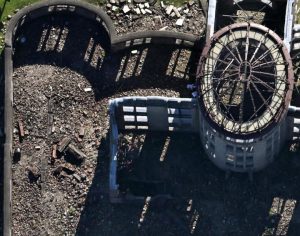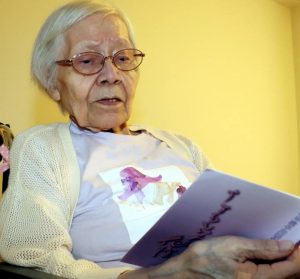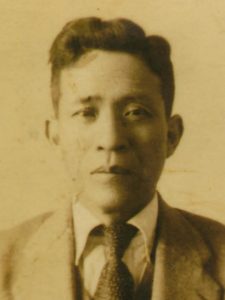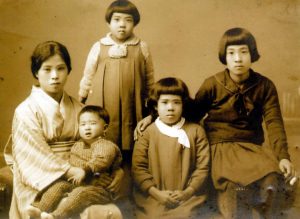Memories engraved in A-bombed buildings, Part 3: A-bomb Dome
Jul. 23, 2024
Symbol of sorrow from losing family members
by Minami Yamashita, Staff Writer
“My entire family died, leaving me alone.”
Ryoko Hashimoto, 96, broke down into tears in her room at a home for the elderly in Nishinomiya City, Hyogo Prefecture, as she gazed at a sepia-toned photograph of her parents and sisters. In the atomic bombing, she lost all six members of her family, who were living in the central part of Hiroshima City, including her older sister, who worked at the Hiroshima Prefectural Industrial Promotion Hall (present-day A-bomb Dome). “The dome is a place where I feel sorrow and anger. If there had been no atomic bomb, my entire family would have been fine.”
Told true parents were aunt and uncle
Ms. Hashimoto was adopted in her early childhood by her aunt and uncle, who were childless, and grew up in the Kansai region. She was told that her true parents and four sisters were her aunt, uncle, and cousins. During summer vacations, she would play with them in Hyogo and in Tokyo, their hometown. She says, “My oldest sister was kind and did her best to entertain me, while my other older sister was a solid person. My father had a big nose, like me.” Upon parting, they would always give her lots of souvenirs, which made her younger sisters jealous.
In May 1945, her father Hisashi Kamei, 50 at the time of the atomic bombing, and the rest of the family moved from Tokyo to Hiroshima because of a job transfer. They settled in the area of Shimonaka-machi (in the city’s present-day Naka Ward). Her mother, Ai, 46 at the time, wrote in a letter, “Unlike Tokyo, Hiroshima is quiet and a good place to live.” That was the last time Ms. Hashimoto heard from her mother.
Three months later, in Ehime Prefecture where she had been evacuated, Ms. Hashimoto learned of the deaths of her “aunt, uncle and cousins.” Her older sister, Yukiko, 21 at the time of the bombing, is believed to have died in the Hiroshima Prefectural Industrial Promotion Hall, where she worked, while her younger sister, Sumiko, 10 at the time, is believed to have been killed at Fukuromachi National School (present-day Fukuromachi Elementary School).
Ms. Hashimoto’s mother and another sister, Yasuko, 20 at the time, experienced the atomic bombing at home. She explained that her father tried to save the two, who had become trapped under the collapsed house. But her mother told him “make sure you survive and look after our other daughters,” upon which he left them reluctantly, with feelings of deep regret. Ms. Hashimoto says, “She was a very kind mother. I’m sure she remembered me, who she gave up for adoption when I was young.” Her mother and three sisters were never found, not even their remains. Her father, who had suffered severe burns, died two weeks after the atomic bombing.
It was around the time she graduated from a girls’ high school that Ms. Hashimoto learned she had been adopted. Her mind was filled with questions about why she had been put up for adoption. She says, “I think that my adoptive parents struggled with telling me the truth. But I wanted to know the reality when everyone was still alive and well.” Only another younger sister, Reiko, who had been mobilized for the war effort, survived. However, she died of leukemia at the young age of 30, 15 years after the atomic bombing. “I believe it was caused by exposure to radiation,” said Ms. Hashimoto.
Visits to Hiroshima to comfort souls of dead family
After the war, Ms. Hashimoto made numerous visits to Hiroshima to pay her respects to her deceased parents and sisters. Her husband died when she was in her 50s. She then began writing senryu, humorous 17-syllable poems, to fill the void left by his death, with one of the poems reading, “Still today, I feel the warmth of my mother, who died in the A-bombing.” She said, “I have lived long enough to make up for everyone in my family who died. But I would still like to have a photo taken of me and my mother with my arms around her.”
Even now, with weakened legs, she has a strong desire to visit Hiroshima to be close to her family who died in the atomic bombing. “The aging dome reminds me of time’s passage,” she once wrote. The A-bomb Dome, where her sister Yukiko is assumed to have died, continues to stand 79 years after the atomic bombing as a symbol of her family’s “tragedy.”
Keywords
A-bomb Dome
Completed in 1915 as the Hiroshima Prefectural Commercial Exhibition Hall, it was renamed the Hiroshima Prefectural Industrial Promotion Hall in 1933. In addition to selling and exhibiting products made throughout the prefecture, the hall was used as a museum and an art gallery. In March 1944, regular business operations were suspended, and the hall was used for a variety of offices, including as a branch office for the Japan Home Ministry’s Chugoku-Shikoku Public Works Office and for the Hiroshima Prefectural Lumber Company. People who were inside the hall died instantly when the bomb was dropped, but the exact number remains unclear. Some called for demolition of the building, but in 1966, a decision was made to permanently preserve the structure. In 1996, the A-bomb Dome was registered as a World Heritage Site by the United Nations Educational, Scientific and Cultural Organization (UNESCO).
(Originally published on July 23, 2024)











